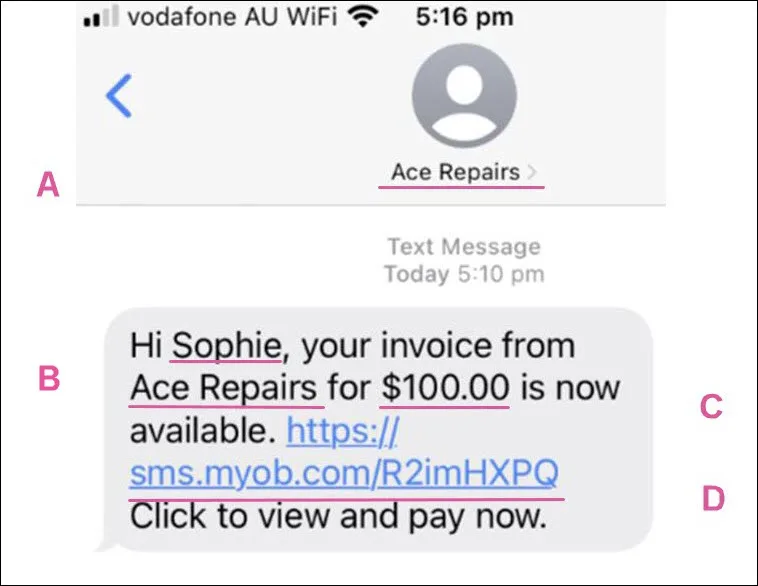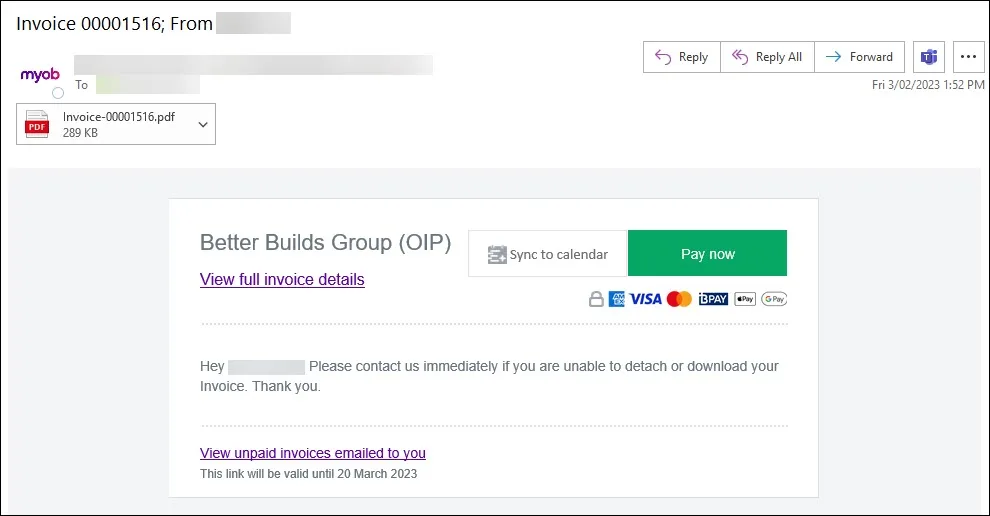MYOB's online invoice payments offer a secure and convenient way to pay invoices online.
A link to pay an online invoice is sent via email and can also be sent via SMS.
Whether you're an MYOB user who sends invoices (the merchant) or you've received an SMS with a link to pay an invoice (the payer), here's how to identify that the message is from a legitimate and trusted MYOB source.
If you believe you are the victim of scam, you need to act fast – see What to do if you're the victim of a phishing scam.
What a typical MYOB invoice SMS looks like

A | The name of the business as recorded in MYOB. Only the first 11 characters of the business name will be displayed, so if the business name is long it may be truncated. |
B | For business-to-consumer (B2C) invoices, the payer's first name and the full business name of the merchant appear. For business-to-business invoices (B2B), only the business name of the merchant appears. |
C | The exact dollar amount of the invoice. |
D | The link to pay the online MYOB invoice. The first part of the link will always contain https://sms.myob.com followed by a unique string of letters and numbers. You can be confident that the link is legitimate if it contains this address: if you put https://sms.myob.com into a web browser it opens the MYOB website. When you click the full link, it opens the payment options page in a web browser: |
Signs of a scam SMS message
Scam SMS messages may be indicated by:
strange grammar or poor spelling
urgency – the scammer wants you to click their fake link, and so may use pressure ('Click now to avoid a late fee!'). A genuine MYOB SMS message won't have this urgency, it will only be like the one described in the table above.
non-myob links – hover your mouse over the link text to see if it genuinely goes to the https://sms.myob.com address.
unfamiliarity – it's sent from a company you haven't previously dealt with, or you don't remember purchasing anything from them.
If you receive an SMS, you'll also receive an email
You can also check your email inbox for the invoice – an invoice email is always sent when an SMS invoice message is sent from MYOB (but note that you can receive an email without an SMS message).
An invoice email typically looks like this:

A genuine invoice email from MYOB:
will always have a PDF of the invoice attached
will contain MYOB in the address when you hover over the Pay now button
will only come from accountright@apps.myob.com or noreply@apps.myob.com
Other email and SMS tips
ask yourself if you expected to receive the email or SMS
check it against previous emails or SMS messages from the same company. Does the email address, design and style of writing match what you usually receive?
use common sense. If you’re unsure about a message, use an external method of communication (such as a phone number from the company’s website) to contact the company that sent the email or SMS.